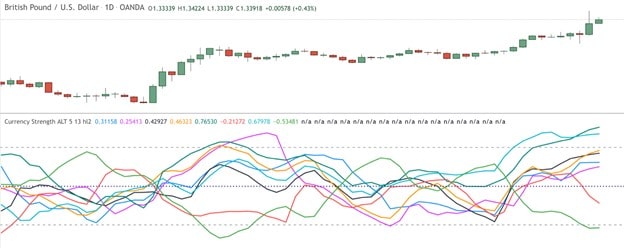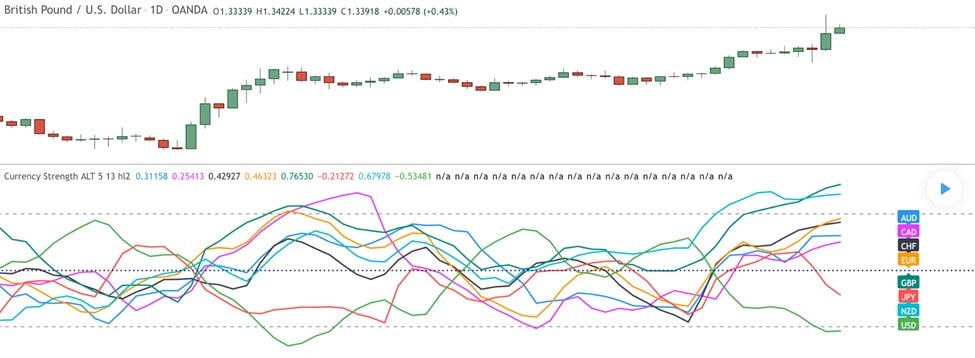

The Currency Strength Meter: A Complete Guide
So, how do we define the strength of a currency? There are different ways, one of which is fundamental analysis. However, it's not 100% accurate.
What provides a clearer insight into a currency is the currency strength meter. Read on to learn more about this lesser-known but interesting indicator.
Currency Strength Meter: Definition
The currency strength meter is a general name given to the indicator that shows whether you're dealing with a strong or weak currency. This algorithm-based indicator relies on the exchange rates of various currency pairs to provide the degree of each currency's strength.
The currency strength meter analyses each currency individually, not the currency pair itself.
You might be familiar with the standard RSI indicator, Awesome Oscillator or MACD tool. But with the currency strength meter, it's more complicated because there's no standard tool. You can find different versions of it on the Internet and customise them to the platform you use.
To find the right version, you should apply several and see which one works best for you. Also, it's worth reading reviews on the indicators you want to use.
The currency strength meter refers to various indicators that measure the strength or weakness of a currency.
Because there's more than one version of the meter, you should know the differences. The more advanced types implement their own weightings and may include other indicators that measure a currency's strength. That helps to provide trading alerts. Simpler versions, on the other hand, don't use any weighting.
However, the main principle remains similar. To depict the strength or weakness of EUR, the indicator calculates the strength of the pairs that include the EUR (for instance, EUR/USD, EUR/GBP and EUR/JPY). After the calculations, we get the overall strength of the Euro.
The indicator is widely used on MetaTrader 4 (MT4) and MetaTrader 5 (MT5). You can also find it on any platform where custom indicators are supported or on the web.
What the Currency Strength Meter Looks Like
Usually, we provide a real-world example that shows you what the indicator looks like and how it works in the real market. It's more complicated with the currency strength meter since there are different variants of it.
The most common currency strength meter consists of lines that move around the zero level. Depending on the algorithms and parameters applied, the lines can have different colours and be smooth or rough.

Another type of currency strength meter is a correlation matrix. It highlights the strength of currencies on different timeframes.

How Does the Currency Strength Meter Work?
The main idea of any currency strength meter consists of the following points:
- The indicator identifies the base currency.
- Then it pairs the currency with all other currencies that are available for such action.
- After that, the indicator measures the strength of each paired currency.
- In the end, an average score is calculated.
The goal of using the indicator isn't to define a strong currency and start buying it but to identify whether the currency is strong or weak in a pair. For example, we have the EUR/USD pair. If it rises, it doesn't necessarily mean the Euro is strong; the US dollar may be weak.
The indicator isn't used to define a strong currency and buy it but to identify whether it's strong or weak in a pair.
As we said above, there are different versions of the indicator. Even though each can have a specific measuring system, a range of 0-10 is the most common. Usually, if the reading is closer to 10, the currency is stronger.
Let's look at how the line currency strength meter works.
The indicator consists of lines that depict currencies. These rules apply to any line version of the currency strength meter:
- The higher line depicts the stronger currency. The signal is stronger if the first line is above the zero line while the line of the other currency is below 0.
- If the line goes up, the currency gains momentum.
- If the line moves downwards, the currency weakens.

You can integrate a currency strength meter into your own strategies and trading style.
Currency Strength Meter in Action
Now that we have an idea of how the currency strength meter works, let's take an in-depth look at how to use it in real trading.
Usually, the indicator is used to either confirm a trend or its reversal. By applying it to a chart, you can define which of the currencies is the weak one and which is the strong one. That way, you'll know which currency pair to buy and which one to sell.
However, you should remember that the currency won't be equally strong or weak relative to other currencies in pairs.
The main idea is to buy a strong currency against a weak one or sell a weak one against a strong one.
Approach 1: Find the Strongest and the Weakest
This approach is best for beginners or if you don't want to overcomplicate your strategy. All you need to do is define the strongest currency and the weakest one and trade their pair.
For example, if AUD is the strongest and EUR is the weakest, you should sell the EUR/AUD pair. You'll simply trade in the trend's direction. The same approach can apply to the trend reversal if you see that the currency has reached extreme readings of strength or weakness.
Approach 2: Average Readings
Of course, it doesn't mean you can only trade if there are extremes in currency readings. However, this approach is riskier because the currency's strength doesn't have a determined limit as gold does, for instance. Thus, it means the currency can continue getting stronger or weaker, and you'll simply stay in a bad trade.
Currency Strength Meter: Limitations
Like any other technical tool, the forex strength meter has limitations that you should consider while trading.
No Guarantee
The currency strength meter doesn't give a 100% accurate understanding of the currency's strength or weakness.
When applying this technical indicator, traders believe that USD's strength or GBP's weakness means it's time to sell the GBP/USD pair. It's not quite like that: the currency strength meter simply provides additional confirmation. However, it's not a trigger for your trades.
A trader should also be careful when implementing the indicator on different timeframes. If the indicator shows that EUR is strong on the 1-hour timeframe, it doesn't mean the currency is strong on a monthly one.
Also, it's vital to follow the current market situation when you're actively trading. Strength or weakness can be a short-term occurrence caused by fundamental issues.
It Measures Strength Relative to Major Currencies
You know there are major currencies that are highly liquid and exotic currencies that are highly volatile and illiquid.
If you see USD is stronger than TRY, it doesn't mean it'll also be stronger than GBP or JPY, for instance. Don't make false conclusions: instead, measure the strength of the currency against major peers.
Higher Timeframes Are Better
Although the indicator can be applied to any timeframe, only higher periods provide a more accurate measurement of a currency's strength.
Too Many Versions
Another disadvantage of the currency strength meter is the wide variety of versions it has. It's challenging for a trader to figure out which one is the best version.
Using the Real Currency Strength Meter: Benefits
Despite the limitations we just discussed, the currency strength meter has many advantages, which is why it's used by traders worldwide.
Useful Currency Strength Meter
Although the indicator doesn't provide 100% accurate signals, it's useful when identifying a trade's direction. The indicator can provide an overview of a wide range of currencies.
Simplicity
The indicator is simple to use. All you need to do is apply the indicator, and it'll do all the calculations itself. Moreover, you don't need to change settings.
It Can Be Applied for Free
There are many versions of the indicator, and they're openly available on the web. So, you can simply find free versions and try them all.
It Saves You Time
The indicator allows investors to skip hours of fundamental analysis. Of course, it doesn't mean you should neglect fundamental analysis, but it does confirm trading ideas.
It Filters Currency Correlations
When trading multiple pairs, you should always remember that currencies can have a negative or positive correlation. The currency strength meter will show you whether currencies are both strong or weak. Even if you see that the currencies included in the pairs are both strong, the pairs usually move in opposite directions, so don't open the same trades.
Alerts of High-Risk Trades
The currency strength meter can prevent you from double risk. For instance, opening the same trade for negatively correlated pairs is a double risk. If you know that one of the currencies is strong and the other doesn't signal strength or weakness, you shouldn't open opposite trades for these pairs.
Tips for Traders: How to Use the Indicator to the Fullest
We'd like to share some tips that will allow you to use any version of the currency strength meter.
- Don't trade negatively correlated currencies in the same direction. This rule applies to correlation strategies when you shouldn't open trade in the same direction, knowing that pairs mostly move in opposite directions. The currency strength meter is a part of this rule. Even if you see that currencies included in the pairs are both strong, but the pairs usually move in opposite directions, don't open the same trades.
- Diversify. The currency strength meter can help you diversify your portfolio. You can open a trade with a currency that is losing its strength and open an opposite trade with a currency gaining momentum. This strategy doesn't give any guarantees against losses, but it can help limit them.
Currency Strength Meter: Is It Worth Using?
A currency strength meter is an interesting tool that can provide additional signals and valuable information on the market's direction. Although the indicator can't give 100% accurate signals, it can become a vital part of your strategy.
The main disadvantage of this indicator is the wide variety of its versions. Before you find your perfect option, you'll have to try many indicators. Fortunately, there are free versions.
So, to find your perfect tool, we recommend using a demo account like Libertex's, which can help you practice your strategies using the currency strength meter. The fact that this indicator is customised makes it possible to implement on any trading platform.
FAQ
How Do You Measure the Strength of a Currency?
There are many versions of the currency strength meter. But usually, they use a range between 0 and 10 to measure a currency's strength, with 10 indicating the strongest currency.
What Is the World's Weakest Currency?
There is no such thing as the world's weakest currency. Every currency can be strong or weak depending on the period and timeframe you use.
How Do You Know If a Currency Is Weak or Strong?
To figure out whether a currency is weak or strong, you can apply the currency strength meter.
How Do You Read Currency Pairs?
Let's consider an example. If the EUR/USD pair rises, it means EUR is stronger than USD, but it doesn't mean that USD per se is weak.
What Makes One Currency Stronger Than Another?
Currencies represent domestic economies. If the economy is strong and the political situation is stable, the currency will appreciate in value.
What Strengthens or Weakens a Currency?
Many factors can affect a currency's strength, including economic reports, news and supply and demand. All of these are vital forces that affect currencies.
Disclaimer: The information in this article is not intended to be and does not constitute investment advice or any other form of advice or recommendation of any sort offered or endorsed by Libertex. Past performance does not guarantee future results.
Why trade with Libertex?
- Get access to a free demo account free of charge.
- Enjoy technical support from an operator 5 days a week, from 9 a.m. to 9 p.m. (Central European Standard Time).
- Use a multiplier of up to 1:30 (for retail clients).
- Operate on a platform for any device: Libertex and MetaTrader.